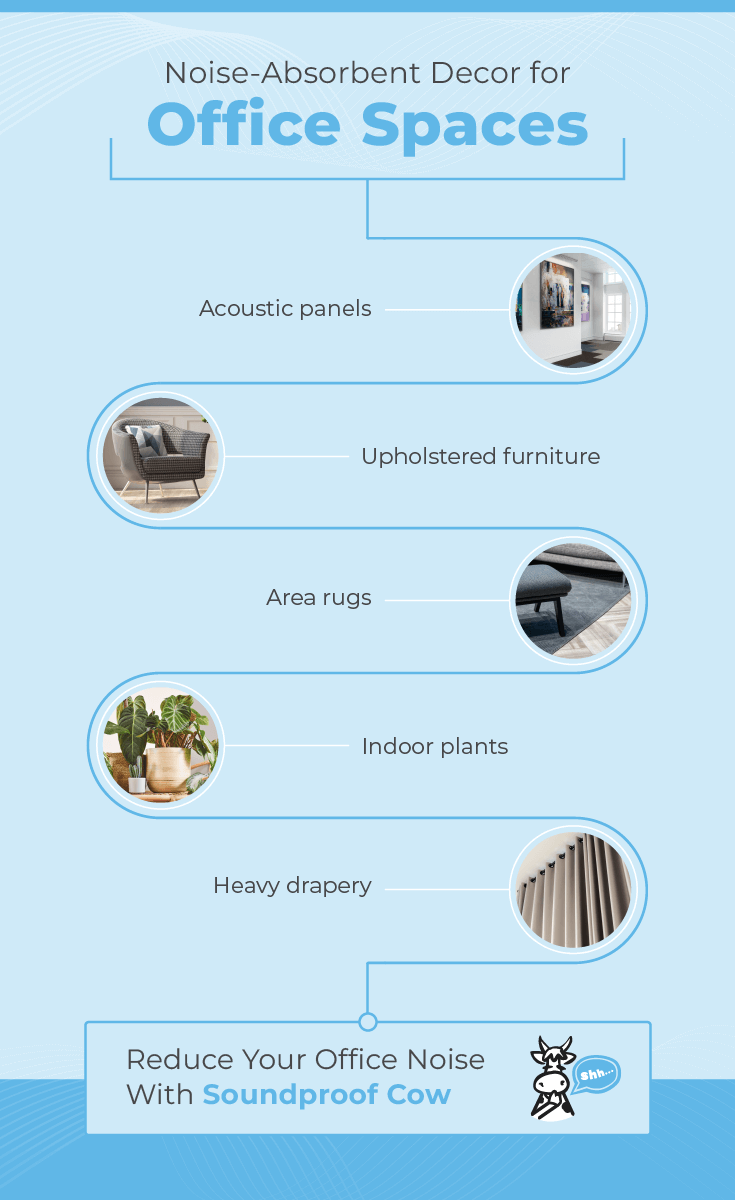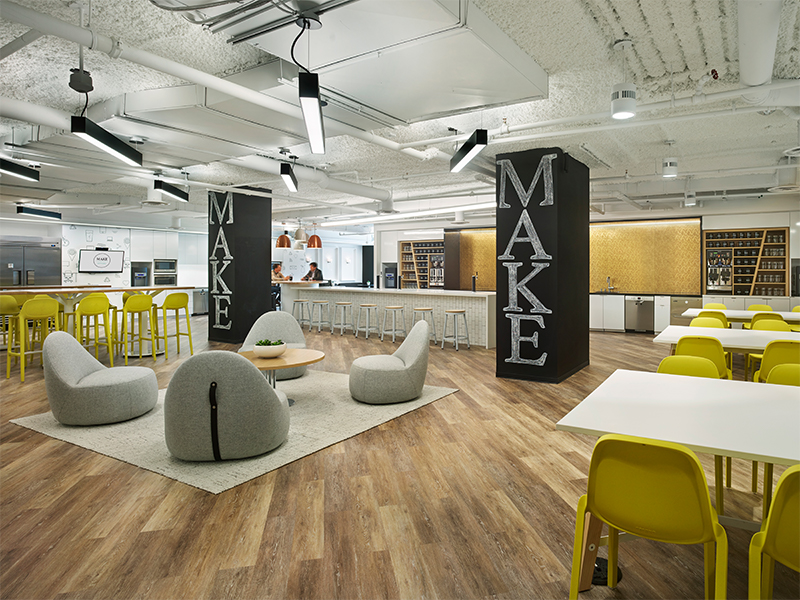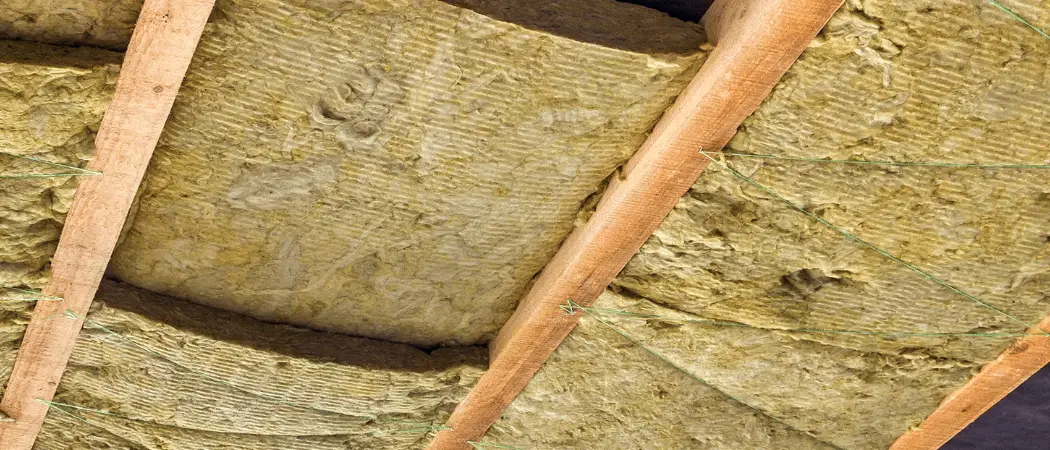To make an office more soundproof, add soundproof curtains and wall panels to absorb noise effectively. Enhancing soundproofing in the workspace can improve concentration and productivity.
Whether it’s reducing external noise or limiting sound transmission within the office, implementing soundproofing solutions can create a more peaceful and focused environment for employees. With the use of soundproof materials like acoustic foam panels, weatherstripping, door sweeps, and area rugs, you can effectively minimize noise distractions in the office.

By strategically placing sound-absorbing elements and addressing sources of noise, you can transform your office into a quieter and more conducive work environment. Noise reduction measures not only enhance employee satisfaction but also contribute to overall workplace well-being and efficiency.
Identify The Noise Sources
Discover the sources of noise that disturb your office environment and learn effective techniques to make your workspace more soundproof. Enhance productivity and focus by implementing practical strategies to minimize external noise disturbances in your office setting.
Noise can be a major distraction in the office, affecting employee productivity and overall work environment. To effectively make an office more soundproof, it is crucial to identify the noise sources and address them accordingly. By doing so, you can create a quieter and more comfortable workspace for everyone. In this article, we will discuss the process of identifying noise sources, dividing them into two categories: external noise and internal noise.
Assessing External Noise
External noise refers to the noise that enters the office from outside sources, such as traffic, construction, or nearby establishments. Assessing external noise is the first step towards making your office more soundproof. By understanding where the noise is coming from, you can take appropriate measures to minimize its impact.
Here are some effective ways to assess external noise:
- Walk around the office perimeter and listen for any noticeable noise sources.
- Identify the primary sources of external noise, such as busy roads or construction areas.
- Use a sound level meter to measure the intensity of noise from different directions.
- Take note of peak noise periods to have a better understanding of when the distractions are at their highest.
- Consult with professionals who specialize in soundproofing to conduct a comprehensive assessment of the office environment.
Identifying Internal Noise
Internal noise refers to the noise generated within the office itself, which can include conversations between employees, phone calls, equipment vibrations, and air conditioning systems. Identifying internal noise sources is essential to address the root causes and find suitable solutions.
Follow these steps to identify internal noise sources:
- Observe the office during different times of the day to pinpoint when noise becomes an issue.
- Pay attention to frequently used areas, such as conference rooms or break areas, where noise tends to accumulate.
- Identify the main culprits of internal noise, such as loud equipment or doors that slam shut.
- Conduct surveys or have discussions with employees to understand their perspectives on the most disruptive noise sources.
- Consider using decibel meters or noise logging devices to measure and record noise levels in various areas of the office.
By diligently assessing both external and internal noise sources, you can gain valuable insights into the exact areas that require soundproofing measures. This knowledge will enable you to tackle the problem at its source and create a more peaceful and productive office environment for everyone.

Credit: www.soundproofcow.com
Strategically Position Furniture
Strategically position furniture to make your office more soundproof. By rearranging desks, shelves, and partitions, you can create a quieter workspace and minimize distractions.
Choosing Sound-absorbing Materials
Opt for heavy curtains to muffle noise and carpet with thick padding.
Create a cozy area rug using wool or shag for sound reduction.
Arranging Furniture For Noise Reduction
Place bookshelves filled with books against the walls to deflect sound.
- Position couches and chairs strategically to reduce noise reflections.
- Arrange office desks in a clustered layout to absorb sound waves.
Install Acoustic Panels
When it comes to creating a quieter and more productive office environment, installing acoustic panels can be a game-changer. These panels are designed to absorb and dampen sound waves, reducing echo and minimizing noise pollution within the workspace. By strategically placing acoustic panels, you can effectively control the acoustics of your office, promoting better focus and concentration among your employees.
Types Of Acoustic Panels
There are various types of acoustic panels available in the market, each designed to serve different purposes. Understanding the options can help in selecting the right panels for your office:
- Fabric-Wrapped Panels: These panels are aesthetically pleasing and come in a wide range of colors and designs, making them suitable for enhancing the office decor while reducing noise.
- Diffuser Panels: These panels scatter sound waves, preventing them from reflecting directly back into the room, thus minimizing echo and improving overall acoustics.
- Foam Panels: Ideal for controlling mid to high-range frequencies, foam panels are lightweight and versatile, making them easy to install in various office settings.
Placement And Installation
Installing acoustic panels in the right locations is crucial for achieving optimal soundproofing results. Here are some tips for the placement and installation of acoustic panels:
- Identify Noise Sources: Determine the primary sources of noise in your office and focus on installing panels in these areas to effectively reduce sound transmission.
- Strategic Mounting: Place the panels strategically on walls and ceilings where sound reflections and reverberations are most prominent, such as near workstations or conference rooms.
- Professional Installation: For larger or complex installations, it’s advisable to seek professional assistance to ensure the panels are securely and correctly mounted for maximum effectiveness.
Seal Windows And Doors
To make your office more soundproof, one effective strategy is to seal windows and doors properly. By ensuring that there are no gaps or leaks, you can significantly reduce the amount of noise entering or leaving your workspace.
Weather Stripping For Windows
When it comes to soundproofing windows, using weather stripping is a cost-effective solution. This will help seal any gaps or cracks around the window frames, preventing sound from passing through.
Sealing Gaps In Doors
To eliminate noise leakage through doors, it is essential to check for any gaps or spaces that may be letting sound in or out. Seal any gaps with weather stripping or door sweeps to improve soundproofing.
Enhance Flooring And Ceiling
Enhancing the flooring and ceiling in an office can significantly reduce noise and create a more peaceful work environment. By using specific materials and acoustic solutions, you can effectively minimize sound disruptions, improving overall productivity and focus.
Carpeting And Rugs For Noise Reduction
Carpeting and rugs are excellent sound-absorbing options that can help minimize the transmission of noise in an office. The soft texture of carpets and rugs helps to dampen sound vibrations, reducing the overall noise level. Consider installing carpet tiles for easy maintenance and flexibility in design, ensuring comprehensive coverage to optimize noise reduction.
Using Acoustic Ceiling Tiles
Acoustic ceiling tiles prove to be an effective solution for minimizing noise transmission within an office. These specialized tiles are designed to absorb and reduce the propagation of sound waves, enhancing the overall acoustics of the space. By replacing traditional ceiling tiles with acoustic counterparts, you can significantly improve the office’s soundproofing capabilities, creating a more conducive working environment.
Soundproofing Walls
When it comes to creating a quiet and productive office environment, soundproofing the walls is an important step. By reducing noise transmission from outside the office and minimizing sound reverberation within, you can create a peaceful and focused atmosphere for yourself or your employees. There are several effective methods for soundproofing walls that can help to block unwanted noise and enhance the overall privacy of your office space.
Adding Mass To Walls
If you’re dealing with excessive noise coming from adjacent rooms or outside sources, adding mass to the walls can significantly reduce sound transmission. One effective way to achieve this is by installing extra layers of drywall. By doubling up on the existing drywall or using specially designed soundproof drywall, the mass of the wall is increased, effectively minimizing noise transfer. Another option is to hang mass-loaded vinyl (MLV) or soundproof curtains on the walls, as they can add an additional barrier to sound waves.
Using Soundproofing Paint Or Wallpaper
In addition to adding mass, another method to consider is using soundproofing paint or wallpaper. These specially formulated products are designed to absorb and dampen sound waves, reducing noise transmission through the walls. Soundproofing paint uses a combination of materials such as latex, ceramic microspheres, and sound-dampening additives to create a barrier against sound. Similarly, soundproofing wallpaper is made with sound-absorbing materials that help to absorb and dissipate noise. Both options can be easily applied to the walls, providing an extra layer of soundproofing without making any significant changes to the existing structure.
By implementing these soundproofing techniques, you can transform your office into a quiet and peaceful workspace. Whether you choose to add mass to the walls or use soundproofing paint or wallpaper, these methods can make a noticeable difference in reducing noise and improving the overall acoustic quality of your office environment.
Invest In Soundproof Curtains
Elevate your office’s soundproofing by investing in soundproof curtains. These curtains are designed to block out external noises, creating a quieter and more focused work environment. With their sleek appearance and practical functionality, soundproof curtains offer a simple yet effective solution to minimize distractions in any office setting.
One of the most effective ways to create a quiet and peaceful environment in your office is by investing in soundproof curtains. These curtains are specially designed to block out external noise and keep your workspace distraction-free. Not only do they provide sound insulation, but they also add aesthetic value to your office decor. In this section, we will discuss the features of soundproof curtains and the installation process so that you can effectively soundproof your office.
Features Of Soundproof Curtains
Soundproof curtains are equipped with a range of features that make them highly efficient in reducing noise transmission. Here are some of the key features:
- Multiple Layers of Material: Soundproof curtains often consist of multiple layers of densely woven fabric, which helps to absorb and dampen sound waves, preventing them from entering or exiting the room.
- Sound-Blocking Core: To achieve optimal soundproofing, these curtains may contain a sound-blocking core material, such as mass loaded vinyl or fiberglass, that further adds to their noise reduction capabilities.
- Tightly Sealed Edges: Soundproof curtains are designed with tightly sealed edges to minimize any sound leaks around the curtain, ensuring that the maximum amount of noise is blocked.
- Heavyweight Fabric: The heavyweight fabric used in soundproof curtains helps to enhance their sound-blocking properties and increase their overall effectiveness in reducing noise levels.
- Fire-Retardant: Many soundproof curtains come with fire-retardant properties, providing an added layer of safety and protection in your office space.
Installing Soundproof Curtains
Installing soundproof curtains in your office is a simple and straightforward process. Here’s a step-by-step guide to help you:
- Measure and choose the right size: Before purchasing soundproof curtains, measure the height and width of your windows or doors to ensure a proper fit.
- Mount curtain rods or tracks: Install curtain rods or tracks above your windows or doors, following the manufacturer’s instructions.
- Hang the curtains: Place the soundproof curtains on the rod or track and ensure they are evenly spread across the window or door.
- Seal any gaps: To maximize the soundproofing effect, seal any gaps around the window or door using weatherstripping or caulk to prevent sound leaks.
- Optional: Layer curtains: For additional sound insulation, you can layer the soundproof curtains with regular curtains or blinds.
- Enjoy a quieter office: Once the curtains are installed, sit back, relax, and revel in the improved sound quality within your office space.
Manage And Minimize Equipment Noise
To manage and minimize equipment noise in the office, focus on insulating electronics and strategically placing noisy equipment.
Insulating Electronics
Encase computers and printers in soundproofing materials to reduce noise levels.
Install acoustic panels around electronic devices to dampen sound vibrations.
Strategic Placement Of Noisy Equipment
Position loud equipment away from workstations to minimize disruption.
Use sound barriers or partitions to block noise from spreading.
Create White Noise
Creating white noise can significantly help in soundproofing an office environment. By utilizing white noise machines and nature sounds, you can effectively minimize distractions and improve the overall acoustics in the workplace.
Using White Noise Machines
White noise machines are devices designed to emit a consistent, soothing sound that can mask background noise. These machines are particularly useful in open-plan offices where conversations and other sounds can travel easily. Positioning white noise machines strategically throughout the office can help create a more uniform sound environment, reducing the impact of sudden loud noises or conversations on individual workstations.
Working With Nature Sounds
Nature sounds, such as ocean waves, rainfall, or rustling leaves, can also be used to create a calming audio backdrop that minimizes the impact of external noise. By incorporating nature sounds into the office environment, you can provide a sense of tranquility and relaxation, contributing to a more peaceful and focused atmosphere.

Credit: www.amazon.com

Credit: www.parterreflooring.com
Frequently Asked Questions On How To Make An Office More Soundproof
How Can I Reduce Traffic Noise In My Office?
To reduce traffic noise in your office, consider using soundproof curtains, rugs, acoustic panels, or white noise machines. Blocking windows, sealing gaps, and adding plants can also help minimize noise distractions.
How Do You Soundproof Thin Office Walls?
To soundproof thin office walls, you can: 1. Add acoustic panels or soundproof curtains. 2. Install insulation or mass-loaded vinyl. 3. Use bookshelves or storage units to create a barrier. 4. Place sound-absorbing materials like carpets or rugs. 5. Consider double glazing the windows for better sound insulation.
How Do I Make My Room 100 Percent Soundproof?
To make your room 100 percent soundproof, follow these steps: 1. Install soundproof windows and doors. 2. Use acoustic panels or foam on walls and ceilings. 3. Seal gaps around windows and doors with weatherstripping. 4. Add heavy curtains or Soundproof blinds.
5. Use rugs and carpets to reduce sound reflection.
How Can I Help My Office Acoustics?
Improve office acoustics by adding sound-absorbing materials, like carpets or curtains. Use wall panels or acoustic ceiling tiles to reduce noise. Consider rearranging office layout and furniture to minimize sound reflections. Implement noise-cancelling technologies or white noise machines for better acoustics.
Conclusion
To sum up, implementing soundproofing solutions in your office can significantly improve productivity and overall well-being. By following the tips mentioned in this blog post, you can create a peaceful and focused work environment for yourself and your employees. Embrace the power of soundproofing for a more efficient workplace.

